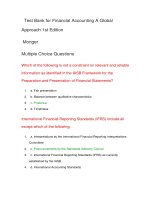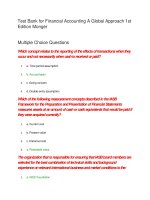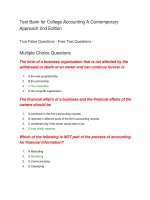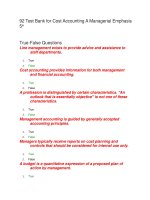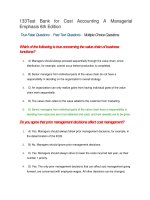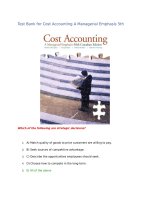133Test bank for cost accounting a managerial emphasis 6th edition
Bạn đang xem bản rút gọn của tài liệu. Xem và tải ngay bản đầy đủ của tài liệu tại đây (190.78 KB, 43 trang )
133Test Bank for Cost Accounting A Managerial
Emphasis 6th Edition
True False Questions - Free Text Questions - Multiple Choice Questions
Which of the following is true concerning the value chain of business
functions?
1.
A) Managers should always proceed sequentially through the value chain, since
distribution, for example, cannot occur before production is completed.
2.
B) Senior managers from individual parts of the value chain do not have a
responsibility in deciding on the organization's overall strategy.
3.
C) An organization can only realize gains from having individual parts of the value
chain work sequentially.
4.
D) The value chain refers to the value added to the customer from marketing.
5.
E) Senior managers from individual parts of the value chain have a responsibility in
deciding how resources are to be obtained and used, and how rewards are to be given.
Do you agree that prior management decisions affect cost management?
1.
A) Yes. Managers should always follow prior management decisions, for example, in
the determination of the EOQ.
2.
B) No. Managers should ignore prior management decisions.
3.
C) Yes. Managers should always strive to lower the costs incurred last year, as their
number 1 priority.
4.
D) Yes. The only prior management decisions that can affect cost management going
forward, are concerned with employee wages. All other decisions can be changed.
5.
E) Yes. Prior management decisions can affect any area of the business operations,
and commit the organization to the subsequent or continued incurrence of costs in such
areas as material handling, and plant construction, for example.
The approaches and activities of managers in short-run and long-run planning
and control decisions that increase value for customers and lower costs of
products and services are known as
1.
A) value chain management.
2.
B) enterprise resource planning.
3.
C) cost management.
4.
D) customer value management.
5.
E) management information system.
The value chain is the
1.
A) sequence of business functions in which value is deducted from the products or
services of an organization.
2.
B) sequence of business functions in which value is proportionately added to the
products or services of an organization.
3.
C) process by which products and services are critiqued for their value.
4.
D) sequence of business functions in which customer usefulness is added to the
products or services of an organization.
5.
E) sequence of functions in which value is added at specific target areas of
improvement.
Financial accounting
1.
A) focuses on the future and includes activities such as preparing next year's operating
budget.
2.
B) must comply with GAAP (generally accepted accounting principles).
3.
C) reports include detailed information on the various operating segments of the
business such as product lines or departments.
4.
D) is prepared for the use of department heads and other employees.
5.
E) is primarily concerned with profitability analysis.
________ is a strategy that integrates people and technology in all business
functions to enhance relationships with customers, partners, and
distributors.
1.
A) Supply-chain analysis
2.
B) Customer relationship management
3.
C) Value-chain analysis
4.
D) Continuous quality improvement
5.
E) Differentiation
A budget is defined as
1.
A) the qualitative expression of a plan.
2.
B) an aid in controlling income.
3.
C) the quantitative expression of a plan of action by management.
4.
D) the quantitative expression of a plan and an aid in controlling income.
5.
E) an aid in coordinating and implementing a plan.
Developing a new web site to display and demonstrate the company's
products would be part of which value chain function?
1.
A) research and development
2.
B) design of products, services, and processes
3.
C) production
4.
D) marketing
5.
E) distribution
________ is the generation of, and experimentation with, ideas related to new
products, services, or processes.
1.
A) Research and development
2.
B) Design of products, services, or processes
3.
C) Production
4.
D) Marketing
5.
E) Quality control
The text identifies six ways to classify the major differences between
Management and Financial Accounting. The "managers of the organization" is
an example of which of the following classes of differences?
1.
A) Purpose of information
2.
B) Primary users
3.
C) Focus and emphasis
4.
D) Rules of measurement and reporting
5.
E) Time span and type of reports
________ is a philosophy in which management improves operations
throughout the value chain to deliver products and services that exceed
customer expectations.
1.
A) Cost-benefit approach
2.
B) Customer focus
3.
C) Customer relationship management
4.
D) Total quality management
5.
E) Management by objectives
Customer relationship management initiatives use technology to coordinate
all
1.
A) production activities.
2.
B) research activities.
3.
C) customer-facing activities.
4.
D) inventory management activities.
5.
E) aspects of strategy implementation.
Companies use the term customer relationship management (CRM) to
describe
1.
A) a strategy that integrates people and technology in all business functions to
enhance relationships with customers.
2.
B) a strategy that integrates people and technology in all business functions to
enhance relationships with customers and partners.
3.
C) a strategy that integrates people and technology in all business functions to
enhance relationships with customers, partners, and distributors.
4.
D) a strategy that integrates people and technology in a few business functions to
enhance relationships with customers, partners, and distributors.
5.
E) a strategy that integrates people and technology in a few business functions to
enhance relationships with customers and partners.
In what way do managers benefit from the use of a database, or "data
warehouse"?
1.
A) Data can be entered at numerous input terminals within the organization.
2.
B) The managers would not be completely responsible for the information that is
entered into the database system.
3.
C) The managers could combine or adjust these data to answer the questions from
particular internal and external users.
4.
D) The managers do not benefit, as the information requires technical expertise to
retrieve.
5.
E) Managers can store old documents in hard copy.
________ is an operational activity that is essential to corporate performance.
1.
A) Customer focus
2.
B) A key success factor
3.
C) Continuous improvement
4.
D) Supply chain
5.
E) Value chain
When a company works with its supplier to reduce material-handling costs,
this is an example of
1.
A) the customer-driven approach.
2.
B) a conflict of interest.
3.
C) a key success factor.
4.
D) a strategic marketing focus.
5.
E) total value chain or supply chain analysis.
Management accounting
1.
A) helps creditors evaluate the company's performance.
2.
B) helps managers make decisions.
3.
C) is useful for external and internal users.
4.
D) creates technical reports that require external audit for verification.
5.
E) is the same as cost accounting.
Financial accounting is concerned primarily with
1.
A) cost planning and cost controls.
2.
B) external reporting to investors, government authorities, etc.
3.
C) profitability analysis.
4.
D) providing information for strategic and tactical decisions.
5.
E) providing analysis to facilitate long term decision making.
Whose perceptions of the company's products or services are the most
important to the manager?
1.
A) board of directors' perception
2.
B) customers' perception
3.
C) president's perception
4.
D) stockholders' perception
5.
E) competitors' perception
The text identifies six ways to classify the major differences between
Management and Financial Accounting. The statement "Communicate
organization's financial position to external users" is an example of which of
the following classes?
1.
A) Purpose of information
2.
B) Primary users
3.
C) Focus and emphasis
4.
D) Rules of measurement and reporting
5.
E) Time span and type of reports
There is many aspects of a company that managers should focus on. Which
of the following sets describes key success factors for managers in terms of
delivering performance to customers?
1.
A) cost and efficiency, time, quality, innovation
2.
B) cost and efficiency, quality, innovation
3.
C) cost and efficiency, shareholder value, quality, innovation
4.
D) cost and efficiency, management by exception, quality, innovation
5.
E) cost and efficiency, budgeting, quality, innovation
Management accounting
1.
A) measures, analyzes, and reports financial and nonfinancial information to internal
managers.
2.
B) provides information about the company as a whole.
3.
C) reports information that has occurred in the past that is verifiable and reliable.
4.
D) provides information that is generally available only on a quarterly or annual basis.
5.
E) must follow generally accepted accounting principles.
The value chain is the sequence of business functions in which
1.
A) value is deducted from the products or services of an organization.
2.
B) value is proportionately added to the products or services of an organization.
3.
C) rational experimentation is performed to enhance product compatibility.
4.
D) products and services are evaluated with respect to their value to the supply chain.
5.
E) usefulness is added to the products or services of an organization.
________ describe(s) the flow of goods, services, and information from the
purchase of materials to the delivery of products to consumers, regardless of
whether those activities occur in the same organization or with other
organizations.
1.
A) Supply chain
2.
B) Key success factors
3.
C) Continuous improvement
4.
D) Customer focus
The text identifies six ways to classify the major differences between
Management and Financial Accounting. The statement "Past oriented (reports
on 2011 performance prepared in 2012)" is an example of which of the
following classes?
1.
A) Purpose of information
2.
B) Primary users
3.
C) Focus and emphasis
4.
D) Rules of measurement and reporting
5.
E) Time span and type of reports
R&D, production, and customer service are business functions that are all
included as part of
1.
A) the value chain.
2.
B) benchmarking.
3.
C) marketing.
4.
D) the supply chain.
5.
E) the company strategy.
Determining the number of components to put into a computer monitor is an
example of which of the following value chain functions?
1.
A) research and development
2.
B) design of products, services, and processes
3.
C) production
4.
D) marketing
5.
E) distribution
Strategy specifies
1.
A) how an organization matches its own capabilities with the opportunities in the
marketplace.
2.
B) standard procedures to ensure quality products.
3.
C) incremental changes for improved performance.
4.
D) the demand created for products and services.
5.
E) that a company's financial procedures are in compliance with GAAP.
To be successful a company should be
1.
A) customer driven.
2.
B) "driven" by the board of directors.
3.
C) employee driven.
4.
D) management driven.
5.
E) executive driven.
Which of the following is something management accountants should do to
satisfy their users?
1.
A) provide specialized information that given users can use
2.
B) consider only financial measures
3.
C) focus exclusively on internal users
4.
D) follow generally accepted accounting principles
5.
E) focus on planning more than control
What aspect of business analysis focuses on the sequence of business
functions?
1.
A) customer service
2.
B) value chain
3.
C) quality
4.
D) research and development
5.
E) product design
The text identifies six ways to classify the major differences between
Management and Financial Accounting. The statement "Varies from hourly to
15 to 20 years" is an example of which of the following classes of
differences?
1.
A) Purpose of information
2.
B) Primary users
3.
C) Focus and emphasis
4.
D) Rules of measurement and reporting
5.
E) Time span and type of reports
An Enterprise Resource Planning System can best be described as
1.
A) a collection of programs that use a variety of unconnected databases.
2.
B) a single database that collects data and feeds it into applications that support each
of the company's business activities, such as purchases, production, distribution, and
sales.
3.
C) a database that is primarily used by a purchasing department to determine the
correct amount of a particular supply item to purchase.
4.
D) a sophisticated means of linking two or more companies to facilitate their planning
processes.
5.
E) exception reporting system for plant managers.
Place the five business functions in the order they appear along the value
chain: A = Customer service B = Design C = Distribution D = Production E =
Research and Development
1.
A) A, E, B, D, C
2.
B) A, C, D, B, E
3.
C) E, B, D, C, A
4.
D) E, B, A, D, C
5.
E) B, E, D, C, A
"Cost management" describes
1.
A) the actions by managers to increase value for customers while continuously
reducing and controlling costs.
2.
B) the identification of excessive costs in the production process.
3.
C) the satisfaction of customers' needs.
4.
D) actions by managers to satisfy customers while maintaining current cost levels.
5.
E) ensuring all costs remains constant.
In designing strategy, a company must match the opportunities and threats in
the marketplace with
1.
A) those of the CFO (Chief Financial Officer).
2.
B) its resources and capabilities.
3.
C) branding opportunities.
4.
D) capabilities of current suppliers.
5.
E) its competitors.
Enterprise Resource Planning software (ERP)
1.
A) integrates data and provide managers with reports that highlight the
interdependence of different business activities.
2.
B) facilitates "Easy Reporting for Proposals."
3.
C) provides financial reports for each separate enterprise in a conglomerate.
4.
D) is used only by plant managers to create "Exceptional Reports for Production."
5.
E) is free software downloaded over the Internet.
73 FreeTest Bank for Cost Accounting A Managerial
Emphasis 6th Canadian Edition by Horngren Mutiple
Choice Questions - Page 2
An accountant that agrees with the company president to defer the
recognition of a revenue is in a breach of which of the following dimensions
of professional conduct?
1.
A) conduct that is detrimental to the best interests of the public or harms the integrity of
the accounting profession
2.
B) conduct that contravenes an act, the regulations, or the bylaws
3.
C) conduct that displays a lack of competence
4.
D) failure or refusal to co-operate in a practice review
5.
E) participating in a conflict of interest
The primary criterion when faced with a resource allocation decision is
1.
A) cost minimization.
2.
B) reduction in the amount of time required to perform a particular job.
3.
C) achievement of organizational goals.
4.
D) how well the alternative options help achieve organizational goals in relation to the
costs incurred.
5.
E) improving information flow.
The process of preparing a budget
1.
A) enhances coordination and communication across business functions.
2.
B) increases accounting efficiencies.
3.
C) reduces overcapacity.
4.
D) promotes production automation.
5.
E) enhances coordination and communication external to the value chain.
The ________ is primarily responsible for the quality of the information
supplied in both internal and external reports.
1.
A) COO (Chief Operating Officer)
2.
B) CIO (Chief Information Officer)
3.
C) treasurer
4.
D) controller
5.
E) accountant
Which of the following elements is contained within the Implement the
Decision, Evaluate Performance, and Learn category in the Five-Step
Decision-Making Process?
1.
A) Identify the problem and uncertainties.
2.
B) Obtain information.
3.
C) Make predictions about the future.
4.
D) Provide feedback.
5.
E) Make decisions by choosing among alternatives.
An example of a staff management function would be
1.
A) determining that new equipment is required.
2.
B) preparing operating cost estimates for proposed new equipment.
3.
C) developing quality standards for production.
4.
D) ensuring that environmental standards are met.
5.
E) being responsible for attaining a set level of plant income.
Once a plan is implemented, the control process
1.
A) ensures that managers follow the pre-existing plan.
2.
B) should allow the originating manager(s) to keep lower-level managers from making
changes.
3.
C) should be flexible.
4.
D) should be followed rigidly.
5.
E) requires top management permission to change.
Which of the following individuals focuses on reporting and interpreting
relevant financial information used to manage the company?
1.
A) chief financial officer
2.
B) controller
3.
C) line management
4.
D) treasurer
5.
E) accounting manager
Control measures should
1.
A) be set and not changed until the next budget cycle.
2.
B) be flexible to allow for employees who are slackers.
3.
C) be kept confidential from employees so that competitors don't have an opportunity
to gain a competitive advantage.
4.
D) be linked by feedback to planning.
5.
E) provide continuous feedback.
Which of the following would likely constitute a breach of ethics for a
management accountant?
1.
A) to omit pertinent information from a report because it is personally unfavourable
2.
B) to consider disclosing confidential information in order to further your own career
3.
C) to consider disclosing confidential information (ie gained from a third party) in order
to assist your employer / client
4.
D) to report the unethical actions of another party, with the expectation that this will
further your own career
5.
E) to be disruptive in a meeting
Staff management includes
1.
A) manufacturing managers.
2.
B) human-resource managers.
3.
C) purchasing managers.
4.
D) distribution managers.
5.
E) sales persons.
________ includes reporting and interpreting information that helps managers
to focus on operating problems, imperfections, inefficiencies, and
opportunities.
1.
A) Scorekeeping
2.
B) Control
3.
C) Problem-solving
4.
D) Planning
5.
E) Budgeting
Preparation of a monthly report comparing the actual phone bill with the
expected phone costs would be classified as
1.
A) problem identification.
2.
B) scorekeeping.
3.
C) planning.
4.
D) control.
5.
E) information gathering.
Place the five steps in the decision-making process in the correct order: A =
Obtain information B = Decide on and implement one of the alternatives C =
Identify the problem and uncertainties D = Implement the decision, evaluate
performance, and learn E = Make predictions about the future
1.
A) D, B, E, A, C
2.
B) E, D, A, B, C
3.
C) C, A, E, B, D
4.
D) A, E, B, D, C
5.
E) A, C, B, D, E
The person(s) directly responsible for the attainment of organizational
objectives is/are
1.
A) staff management.
2.
B) line management.
3.
C) both staff and line management.
4.
D) the chief financial officer.
5.
E) the internal auditor.
Corporate governance
1.
A) relates to the role of the corporate governor.
2.
B) comprises activities undertaken to ensure legal compliance with laws.
3.
C) is legislated by the federal government.
4.
D) relates only to the regulations provided by the Canadian Securities Administrators.
5.
E) is a voluntary system of compliance approved by each company's board of
directors.
A well-conceived plan allows managers to have the ability to
1.
A) stay with the pre-existing plan when things start to change for the better.
2.
B) leave the system and let the plan continue on its own.
3.
C) underestimate the costs so that actual operating results will be favourable when
comparisons are made.
4.
D) take advantage of unforeseen opportunities.
5.
E) stay the course regardless of the outcome.
A report showing the actual financial results for a period compared to the
budgeted financial results for that same period would most likely be called a
1.
A) strategic plan.
2.
B) management forecast.
3.
C) performance report.
4.
D) revised plan.
5.
E) comparative income statement.
Collecting information to follow through on how actual performance
compares to planned or budgeted performance is referred to as
1.
A) an accounting system.
2.
B) scorekeeping.
3.
C) management accounting.
4.
D) attention directing.
5.
E) problem solving.
Which of the following statements about the cost-benefit approach is true?
1.
A) Resources should be spent if they are expected to better attain company goals in
relation to the expected costs of these resources.
2.
B) In a cost-benefit analysis, both costs and benefits are easy to obtain.
3.
C) Resources should be spent if the costs of a decision outweigh the benefits of the
decision.
4.
D) A cost-benefit approach would not be appropriate for a decision to install a budget
system or not.
5.
E) The cost-benefit approach is more important than behavioural considerations.
Measuring and evaluating performance, and providing feedback are aspects
of
1.
A) scorekeeping.
2.
B) information gathering.
3.
C) problem identification.
4.
D) record keeping.
5.
E) control.
Professional ethics for a Certified Management Accountant in Canada were
established by
1.
A) the CICA.
2.
B) the FASB.
3.
C) the CIMA.
4.
D) the CGAC.
5.
E) the SMAC.
The person(s) responsible for providing advice and assistance to line
managers is/are
1.
A) the controller.
2.
B) the chief financial officer.
3.
C) staff management.
4.
D) the treasurer.
5.
E) the president.
Corporate social responsibility is
1.
A) legislated by government and enforced by the courts.
2.
B) the same as code of ethics passed by the board of governors of a company.
3.
C) the mandatory integration by companies of social and environmental concerns into
their business operation.
4.
D) the voluntary integration by companies of social and environmental concerns into
their business operation.
5.
E) codified in international trade agreements.
As teamwork has become more prominent in the last few years, the traditional
distinctions between staff and line management
1.
A) has increased.
2.
B) has become more important relative to promotions.
3.
C) has diminished.
4.
D) has only been evident in the employee reward system.
5.
E) has become less clear cut in the employee reward system.
The control function may include evaluating
1.
A) the difference between current operating costs and last year's operating costs.
2.
B) the difference between budgeted amounts and actual results.
3.
C) the difference between the original budget and the final adjusted budget.
4.
D) the difference allowed in the current production costs.
5.
E) the difference between the historical cost and the current cost.
Understanding the reasons for any difference between actual results and
budgeted amounts is an important aspect of
1.
A) extended value-chain analysis.
2.
B) forecasting for the next accounting period.
3.
C) kaizen management.
4.
D) control.
5.
E) management by perception.
What is the professional designation for management accountants?
1.
A) Chartered Accountant
2.
B) Certified Management Accountant
3.
C) Certified General Accountant
4.
D) Certified Financial Executive
5.
E) Chartered Management Accountant
For which of the following areas is a chief operating officer (COO) typically
responsible?
1.
A) treasurer
2.
B) non-financial operating functions
3.
C) risk management
4.
D) taxation
5.
E) controllership
Non-compliance with a code of professional ethics for management
accountants includes which of the following penalties?
1.
A) imprisonment of up to two years
2.
B) imprisonment of up to 20 years
3.
C) fines up to $100,000 and imprisonment of up to two years
4.
D) public censure and imprisonment up to 2 years
5.
E) fines, public censure, and loss of license to practice
Which of the following is a major benefit of utilizing a budgeting system?
1.
A) It always results in more profitable decisions.
2.
B) It is easier for managers than traditional decision-making models.
3.
C) It saves costs by utilizing historical data to make projections.
4.
D) It facilitates coordination and communication.
5.
E) Once a successful budget is developed, it can be re-used year after year.
Which of the following is an example of an intrinsic reward?
1.
A) participation in a stock option plan
2.
B) receiving a cash performance bonus
3.
C) being acknowledged for a job well done


